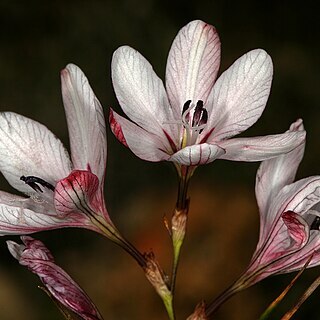Plants mostly 300-500 mm high. Corm subglobose, 15-30 mm diam., sometimes deep-seated; tunics of fine-textured fibres, extending into a thick, fibrous collar. Stem simple or with up to 2 suberect or weakly spreading branches. Leaves 5 to 8, ± erect, firm, compressed-cylindric or ± terete, (150-)200-300(-600) x 1-2(-3) mm, acute, striate with translucent veins when dry but without evident thickened main vein, sometimes as long as stem, cauline leaves dry and clasping, bract-like. Spike erect or arching, rather lax, (3-)6-to 10-flowered; bracts dry and papery, pale and translucent below and brown speckled dark brown at tips, outer (6-)10-15(-18) mm long, obtuse or ± 3-toothed with median tooth sometimes reduced, inner subequal, bifid. Flowers weakly zygomorphic, nodding, inverted, white to cream-coloured or pink to pale pink to rose-pink, darkly veined, unscented; perianth tube cylindric, curving outward, (20-)30-45(-55) mm long, slender, widening in upper 6-8 mm to 5-7 mm diam.; tepals subequal or outer, especially dorsal, wider, spreading, oblong to oblanceolate, (15-)20-25(-30) x (5-)7-10 mm but dorsal 8-14 mm wide, without calluses. Filaments unilateral, ± horizontal, (8-)15-20(-25) long, exserted; anthers 5-10 mm long, facing upward through inversion of flower, purple or cream; pollen violet or cream-white. Style dividing opposite upper 1/2 of anthers, branches 3-5 mm long. Capsules obovoid, 10-12 mm long.
More
Perennial herb, geophyte, 0.4-0.7 m high; corm depressed-globose, tunics of fine, netted fibres, irregularly reticulate; stem simple, 1-3-branched, suberect or slightly flexuose. Leaves linear, subterete, striate when dry, acuminate, 1-3 mm wide. Bracts membranous, dry, speckled brown above, outer 2-or 3-toothed, inner bidentate. Inflorescence a distichous, lax spike; flowers pale yellow or cream-coloured to pale mauve, ± salvershaped; perianth tube cylindrical; tepals spreading, subequal in length, dorsal widest. Stamens erect; anthers facing outwards, violet. Style 27-60 mm long, erect. Flowering time Oct.-Dec. Capsule obovoid.
Cormous geophyte, 40-70 cm. Leaves linear, subterete. Flowers long-tubed, perianth nearly actinomorphic but stamens unilateral, cream-coloured to pale mauve.

